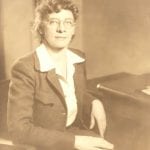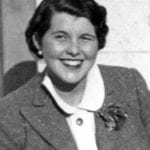
Jessica Park, The Queen Anne Victorian House in Portland, Oregon (detail), 2002, collection of Marcia Johnston Wood
Hans Asperger, 1906-1980
In 1944, Hans Asperger, a Viennese pediatrician, described four boys with “autistic psychopathy.” Decades later, Asperger was credited with independently discovering the same novel syndrome that Leo Kanner described in 1943. In the 1990s, Asperger’s name was transformed into a diagnosis, Asperger syndrome.
“The essential abnormality in autism is a disturbance of the lively relationship with the whole environment.” (1944)
Lauretta Bender, 1897-1987
 Lauretta Bender was a prominent psychiatrist who conducted research on childhood schizophrenia at Bellevue Hospital and Creedmoor State Hospital in New York from the 1930s through the 1960s. Bender was a maverick who believed that autism had organic causes. Several of her studies involved administering electric shock and psychoactive drugs, including LSD, to children.
Lauretta Bender was a prominent psychiatrist who conducted research on childhood schizophrenia at Bellevue Hospital and Creedmoor State Hospital in New York from the 1930s through the 1960s. Bender was a maverick who believed that autism had organic causes. Several of her studies involved administering electric shock and psychoactive drugs, including LSD, to children.
“The schizophrenic child reveals pathology at every level and in every field of integration within the functioning of the central nervous system, be this vegetative, motor, perceptive, intellectual, emotional, or social.” (1942)
Bruno Bettelheim, 1903-1990
 Bruno Bettelheim was one of the most effective popularizers of Freudian ideas in the United States after World War II. He was also the most famous proponent of psychogenesis, which blamed children’s developmental problems on hostile parents, typically mothers, who deprived their children of the love required for normal development.
Bruno Bettelheim was one of the most effective popularizers of Freudian ideas in the United States after World War II. He was also the most famous proponent of psychogenesis, which blamed children’s developmental problems on hostile parents, typically mothers, who deprived their children of the love required for normal development.
“To develop childhood schizophrenia it is sufficient that the infant is convinced that his life is run by insensitive, irrational, and overwhelming powers, who, moreover, have total control over his life and death.” (1956)
Temple Grandin, 1947-
 Temple Grandin is probably the best known individual with autism in the United States today, largely because she has written and spoken widely about her experience. A successful animal scientist who designs humane livestock handling and slaughtering techniques, Grandin is famous for her advocacy of both animal welfare and autism rights.
Temple Grandin is probably the best known individual with autism in the United States today, largely because she has written and spoken widely about her experience. A successful animal scientist who designs humane livestock handling and slaughtering techniques, Grandin is famous for her advocacy of both animal welfare and autism rights.
“Did you ever wonder what an autistic child is thinking? I was a partially autistic child and I will try to provide you with some insight.” (1984)
Leo Kanner, 1894-1981
 A child psychiatrist at Johns Hopkins University, Leo Kanner reported on a new clinical syndrome in 1943. His description of eleven children—eight boys and three girls—afflicted by “disturbances of affective contact” became virtually synonymous with the discovery of autism. Autism was so closely identified with his name that it was sometimes called “Kanner’s syndrome.”
A child psychiatrist at Johns Hopkins University, Leo Kanner reported on a new clinical syndrome in 1943. His description of eleven children—eight boys and three girls—afflicted by “disturbances of affective contact” became virtually synonymous with the discovery of autism. Autism was so closely identified with his name that it was sometimes called “Kanner’s syndrome.”
“The outstanding, ‘pathognomic,’ fundamental disorder is the children’s inability to relate themselves in the ordinary way to people and situations from the beginning of life.” (1943)
Rosemary Kennedy, 1918-2005
 Rosemary Kennedy was the first daughter born to the Kennedy political dynasty. She grew up when mental retardation was considered a shameful secret. When she was 23, her parents agreed to a lobotomy. Rosemary spent the rest of her long life in an institution. Her sister, Eunice Kennedy Shriver, shared Rosemary’s story with the American public in 1962, marking a turning point in the history of developmental disability.
Rosemary Kennedy was the first daughter born to the Kennedy political dynasty. She grew up when mental retardation was considered a shameful secret. When she was 23, her parents agreed to a lobotomy. Rosemary spent the rest of her long life in an institution. Her sister, Eunice Kennedy Shriver, shared Rosemary’s story with the American public in 1962, marking a turning point in the history of developmental disability.
Ivar Lovaas, 1927-2010
 The “Lovaas method” was the basis for Applied Behavior Analysis, a labor-intensive, one-on-one approach to teaching young children with autism. Behaviorist Ivar Lovaas pioneered his method at UCLA during the 1960s, where he worked with severely disabled children considered untreatable by others. His reinforcement procedures included aversive techniques, such as electric shock, alongside positive reinforcements, such as food.
The “Lovaas method” was the basis for Applied Behavior Analysis, a labor-intensive, one-on-one approach to teaching young children with autism. Behaviorist Ivar Lovaas pioneered his method at UCLA during the 1960s, where he worked with severely disabled children considered untreatable by others. His reinforcement procedures included aversive techniques, such as electric shock, alongside positive reinforcements, such as food.
“Given the uncertainty both in regard to etiology and prognosis of the diagnostic label autism, we would prefer to provide a diagnosis of the child in terms of the specific behaviors he does or does not have.” (1974)
Clara Claiborne Park, 1923-2010
 Clara Park published a remarkable, moving book about her family’s experience with an autistic child in 1967, when such parent memoirs were still extremely rare. The Siege challenged prevailing views about the origins and treatment of autism, offered other parents encouragement in the face of professional hostility, and inspired family members to become pioneers of early intervention.
Clara Park published a remarkable, moving book about her family’s experience with an autistic child in 1967, when such parent memoirs were still extremely rare. The Siege challenged prevailing views about the origins and treatment of autism, offered other parents encouragement in the face of professional hostility, and inspired family members to become pioneers of early intervention.
“Confronted with a tiny child’s refusal of life, all existential hesitations evaporate. We had no choice. We would use every stratagem we could invent to assail her fortress, to beguile, entice, seduce her into the human condition.” (1967)
Eunice Kennedy Shriver, 1921-2009
 Eunice Kennedy Shriver was the sister of John, Robert, and Edward Kennedy. In 1962, two years after John’s election to the U.S. presidency, she revealed that they had a sister, Rosemary, with mental retardation. Making Rosemary’s story public made developmental disability more visible culturally and important politically in the United States.
Eunice Kennedy Shriver was the sister of John, Robert, and Edward Kennedy. In 1962, two years after John’s election to the U.S. presidency, she revealed that they had a sister, Rosemary, with mental retardation. Making Rosemary’s story public made developmental disability more visible culturally and important politically in the United States.
“Twenty years ago. when my sister entered an institution, it was most unusual for anyone to discuss this problem in terms of hope. But the weary fatalism of those days is no longer justified.” (1962)
Wolf Wolfensberger, 1934-2011
 Wolf Wolfensberger was an international authority on mental retardation and a champion of the rights of individuals with developmental disabilities. A passionate advocate for community-based services, he aimed to “normalize” the lives of people with disabilities by making opportunities available to them that were as similar as possible to those available to non-disabled citizens.
Wolf Wolfensberger was an international authority on mental retardation and a champion of the rights of individuals with developmental disabilities. A passionate advocate for community-based services, he aimed to “normalize” the lives of people with disabilities by making opportunities available to them that were as similar as possible to those available to non-disabled citizens.
“Of all management models, the normalizing-developmental one is probably most likely to provide the framework for a cathedral of human dignity.” (1972)
